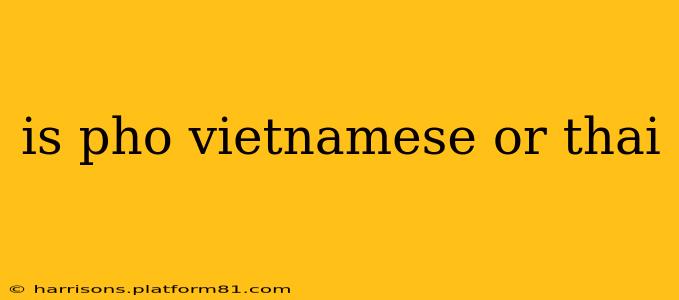The question, "Is pho Vietnamese or Thai?" is a common one, and the answer is clear: pho is unequivocally Vietnamese. While Thai cuisine boasts a rich and diverse array of noodle soups, pho's unique flavor profile, ingredients, and history firmly root it in Vietnamese culinary tradition. Let's delve deeper into why this is the case, addressing some common misconceptions along the way.
What Makes Pho Distinctly Vietnamese?
Pho's origins trace back to northern Vietnam, evolving over centuries into the iconic dish we know today. Its defining characteristics set it apart from any Thai noodle soup:
-
The Broth: The foundation of pho lies in its rich, aromatic broth, often simmered for hours with beef bones, spices like star anise, cinnamon, cloves, and cardamom. This lengthy simmering process creates a deep, complex flavor that is uniquely pho. While Thai soups utilize flavorful broths, they rarely share this specific combination or extended simmering time.
-
The Noodles: Pho uses flat, wide rice noodles, specifically designed to absorb the broth’s flavors. These noodles differ significantly from those found in many Thai noodle dishes.
-
The Herbs and Garnishes: The vibrant array of fresh herbs served alongside pho – including basil, cilantro, lime wedges, bean sprouts, and chili slices – is another key differentiator. While Thai cuisine also uses fresh herbs, the specific combination and way they are used alongside pho are unique.
-
The Meat: While variations exist, beef is a quintessential ingredient in pho, often featuring thinly sliced ribeye or brisket. While Thai soups may include beef, the cuts and preparation differ significantly.
What About Similar-Looking Thai Noodle Soups?
It's true that Thailand possesses delicious noodle soups, and some may visually resemble pho. However, these soups usually differ in several key aspects:
-
Flavor Profile: Thai noodle soups often feature bolder, spicier, and more overtly sweet or sour flavors compared to pho’s subtle, nuanced complexity.
-
Ingredients: The specific herbs, spices, and meats used will differ, sometimes dramatically.
-
Cooking Methods: The preparation techniques used for Thai soups, including the broth-making process, may also differ from those used for pho.
Therefore, while visual similarities might exist, the fundamental differences in flavor profile, ingredients, and preparation techniques firmly establish pho's Vietnamese identity.
How Did the Misconception Arise?
The confusion might stem from the broader similarities between Vietnamese and Thai cuisines, both rich in noodle dishes and fresh herbs. The spread of Vietnamese cuisine globally has also possibly contributed to some misidentification.
Are There Any Fusion Dishes Combining Elements of Both Cuisines?
Yes, the culinary world is constantly evolving, and creative chefs often draw inspiration from various sources. It's entirely possible to find fusion dishes that combine elements of Vietnamese and Thai cuisine. These would, however, represent a deliberate blending of culinary traditions, not a claim that pho itself is Thai.
Is Pho a Regional Dish Within Vietnam?
While pho is enjoyed across Vietnam, its origins are primarily linked to northern Vietnam. Regional variations do exist, with subtle differences in broth, noodles, and toppings reflecting local tastes and ingredients.
In conclusion, the delicious and aromatic pho is undeniably a cornerstone of Vietnamese cuisine, possessing a unique history, flavor profile, and preparation method that distinguishes it from any Thai dish. The next time you savor a bowl, remember its rich Vietnamese heritage!
